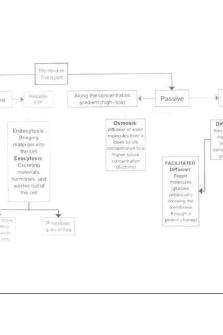Chapter 7 HW Membrane Transport PDF

| Title | Chapter 7 HW Membrane Transport |
|---|---|
| Author | Captain Marvel |
| Course | Intro To Bio Anth |
| Institution | University of Kentucky |
| Pages | 1 |
| File Size | 56.2 KB |
| File Type | |
| Total Downloads | 64 |
| Total Views | 182 |
Summary
My homework about cell membranes....
Description
AP Bio Homework Campbell & Reece textbook, Chapter 7: Membrane Structure & Function. Number and answer the following on a separate sheet of paper. 1. Make a simple drawing of the fluid mosaic model of the cell membrane. Label both ends of the phospholipids, and the surface and transmembrane proteins. 2. What is the significance of the phospholipid arrangement? 3. List four functions of the plasma membrane. 4. Describe the fluid properties of the cell membrane and explain how membrane fluidity is influenced by membrane composition. 5. Explain how hydrophobic interactions determine membrane structure and function. 6. What factors affect the permeability of membranes? 7. Define diffusion; explain what causes it. 8. Explain what regulates the rate of passive transport. 9. Explain why a concentration gradient across a membrane represents potential energy. 10. Define “osmosis” and predict the direction of water movement based upon differences in solute concentrations, osmotic pressure and osmotic potential. 11. Define water potential. Does water osmose from low to high, or high to low water potential? 12. How do living cells (1) with and (2) without walls regulate water balance? 13. Describe facilitated diffusion. 14. What is the Sodium-Potassium Pump? What is it used for? Do you consider this a form of active or passive transport? Why? 15. Explain what mechanisms can generate a membrane potential or electrochemical gradient. 16. Explain how large molecules may be transported across cell membranes. 17. Compare and contrast (a) endocytosis/exocytosis; and (b) pinocytosis/phagocytosis. 18. what is the primary difference between carrier proteins (in the cell membrane) that participate in facilitated diffusion, and those that participate in active transport? 19. Describe what would happen to the molecules in a drop of ink dropped into a beaker of water. What is this process called? 20. Name three types of passive transport and three types of active transport....
Similar Free PDFs

Chapter 7 HW Membrane Transport
- 1 Pages

Membrane Transport Flow Chart
- 1 Pages

Week 2 Membrane transport lab
- 6 Pages

Chapter 7 HW answers
- 8 Pages

Chapter 7 hw - jessica tietjen
- 2 Pages

WEEK 7-HW- Chapter 10
- 5 Pages

Hw chapter 7 - Professor Frega
- 6 Pages
Popular Institutions
- Tinajero National High School - Annex
- Politeknik Caltex Riau
- Yokohama City University
- SGT University
- University of Al-Qadisiyah
- Divine Word College of Vigan
- Techniek College Rotterdam
- Universidade de Santiago
- Universiti Teknologi MARA Cawangan Johor Kampus Pasir Gudang
- Poltekkes Kemenkes Yogyakarta
- Baguio City National High School
- Colegio san marcos
- preparatoria uno
- Centro de Bachillerato Tecnológico Industrial y de Servicios No. 107
- Dalian Maritime University
- Quang Trung Secondary School
- Colegio Tecnológico en Informática
- Corporación Regional de Educación Superior
- Grupo CEDVA
- Dar Al Uloom University
- Centro de Estudios Preuniversitarios de la Universidad Nacional de Ingeniería
- 上智大学
- Aakash International School, Nuna Majara
- San Felipe Neri Catholic School
- Kang Chiao International School - New Taipei City
- Misamis Occidental National High School
- Institución Educativa Escuela Normal Juan Ladrilleros
- Kolehiyo ng Pantukan
- Batanes State College
- Instituto Continental
- Sekolah Menengah Kejuruan Kesehatan Kaltara (Tarakan)
- Colegio de La Inmaculada Concepcion - Cebu








